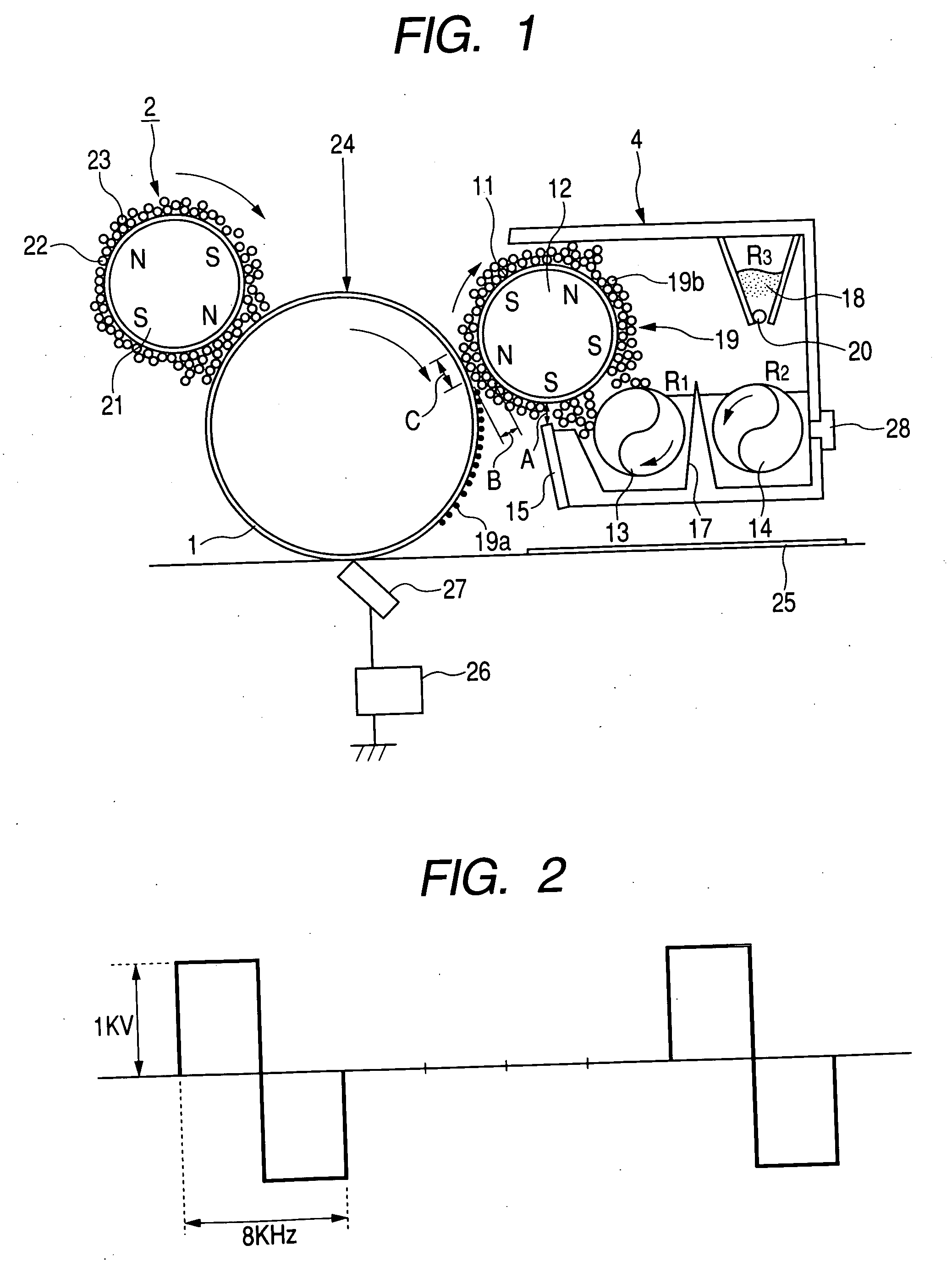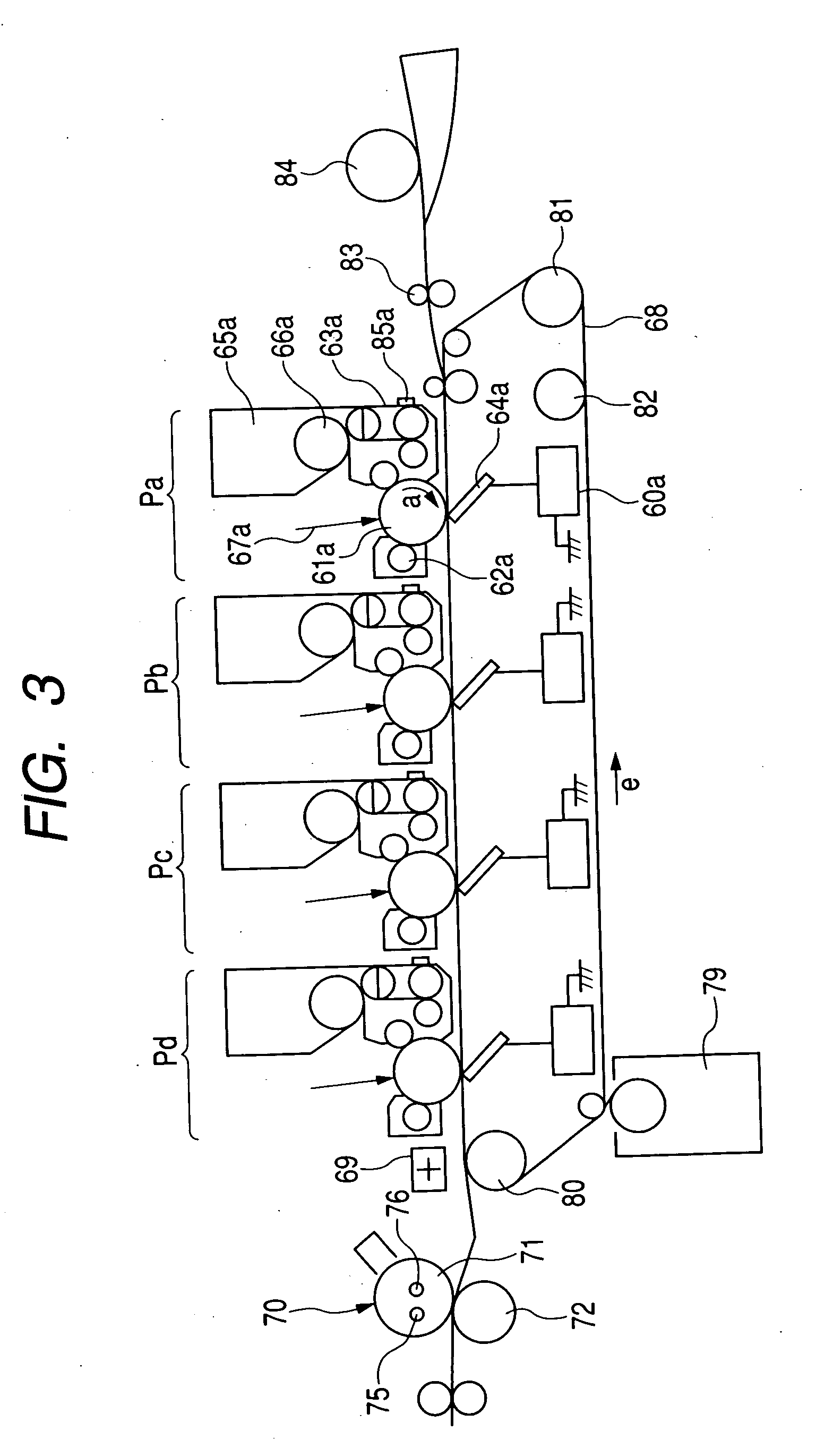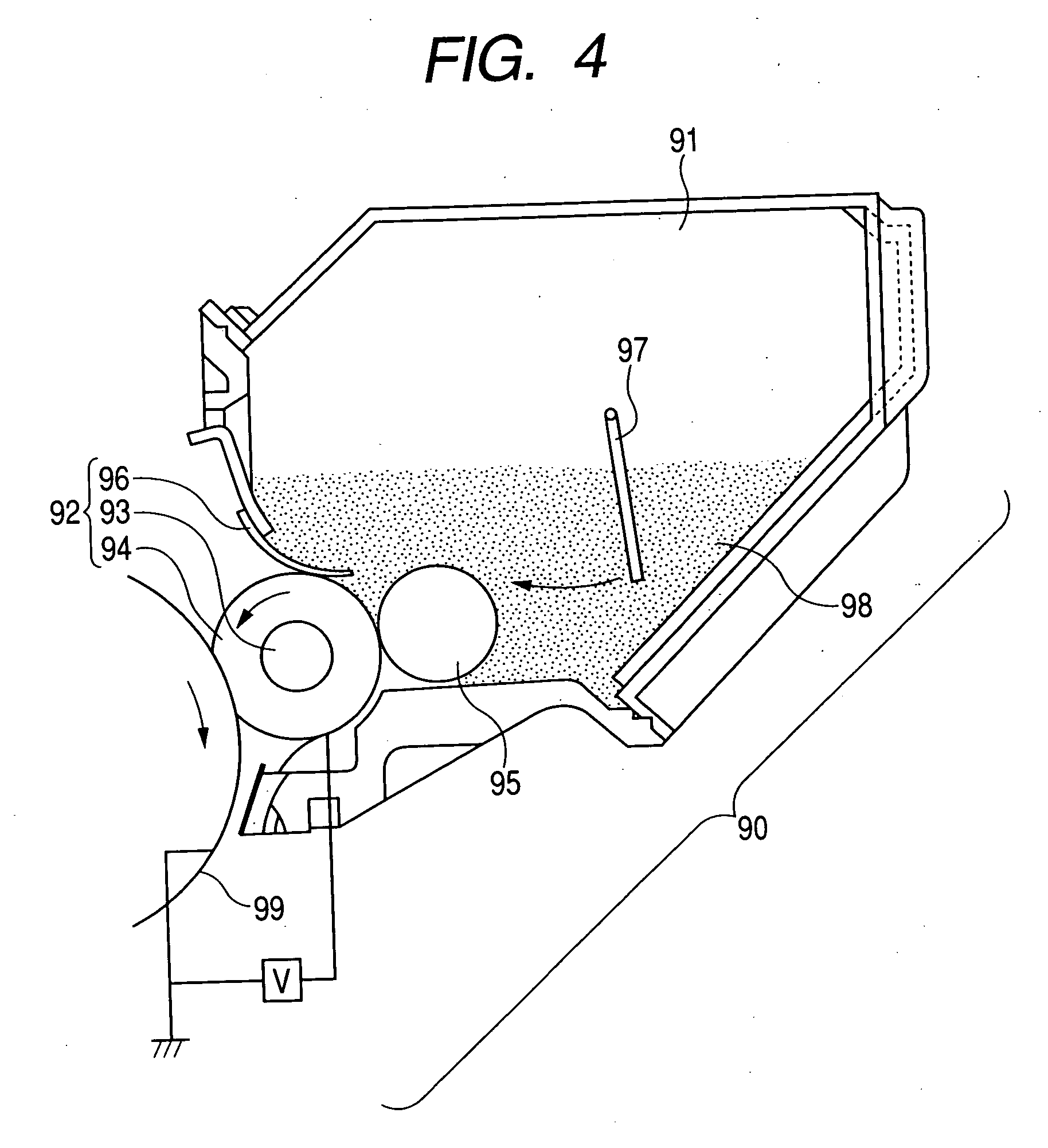However, it has problems to be solved, in respect of specific
image quality items, in particular,
fog at the time of extensive printing, melt adhesion to photosensitive member, toner scattering and so forth.
Such problems are considered to be firstly caused by the facts that i) the use of toners over a long period of time causes deterioration of external additives having been added to toner particles and ii) charge-providing members such as a developing sleeve and a carrier and a toner
layer thickness control member for keeping the
coating of toner on the sleeve to a stated level are contaminated by the toner and the external additives, i.e., toner-spent comes about.
Consequently, a lowering of charge quantity of toners results from these two things, an hence brings about the above problems.
Stated in detail, triboelectric charging is performed by means of physical external force such as contact and collision between the toner and the sleeve in the case of one-component developers and between the toner and the carrier in the case of two-component developers, and hence the toner, the charge-providing members (sleeve and carrier) and the toner
layer thickness control member may necessarily be damaged.
In the charge-providing members and the toner
layer thickness control member, they may be contaminated with toner components including the external additives, or coat components with which the charge-providing members have been coated in order to stabilize charge properly may wear or be broken.
Secondly, the above problems may arise because, where an original having a high
image area percentage is used and where the toner is fed onto the charge-providing members in a large quantity, it takes a time until the toner having been fed is uniformly charged and the toner uncharged participates in development.
Any image defects thereby caused tend to come into question when multi-superimposed images are formed in full-
color image formation, and are especially required to be remedied.
This, however, tends to make toner-spent resistance poor as the carrier has a larger specific surface area.
This, however, goes against the downsizing of
copying machine or printer main bodies, and is not practical.
Meanwhile, steps which are most important for satisfying the demand of users and are technically difficult include the fixing step.
However, it requires a unit for feeding such an offset-preventive fluid, and has a problem that it makes the fixing
assembly complicate, providing an inhibitory factor in the designing of compact and inexpensive systems.
Further, in the case of a transparency film or sheet urilizing an overhead
projector (OHP film or sheet) needed increasingly as its use for presentation, it has a low
oil absorption capacity as being different from paper, and hence the stickiness of the OHP film surface has come into question.
In the case where the fixing-medium sheet is paper as well, it has a problem that its surface is not inscribable with a pen using water-based ink or the like because of the oil absorbed therein.
On the other hand, the use of the
release agent may lower anti-blocking properties of toners, may lower developing performance of toners because of in-
machine temperature rise, or may lower developing performance of toners because of exudation of the
release agent to toner particle surfaces when the toners are left over a long period of time.
However, in the case of high-speed fixing, in which the temperature of the heating member drops violently at the time of continuous paper feed, this technique has some problems in respect of things relating to fixing, such as faulty fixing at the time of low-temperature fixing, what is called a low-temperature offset phenomenon and faulty paper delivery and placement, and in respect of how to ensure stable developing performance over a long period of time.
As a problem in the case of the oilless fixing or small-quantity oil application fixing, the transfer sheet may be put out in such a form that it is pulled toward the fixing member after its leading end on the paper delivery side has passed the fixing nip.
In this case, the problem of faulty placement may arise on the paper delivered in a large number of sheets.
Also, where the above phenomenon occurs at a serious level, the transfer sheet may wind around the fixing member to cause the faulty paper delivery.
However, in the case of providing the separation claw in contact with the fixing member, the offset toner having stagnated at the separation claw or the like may enlarge the
contact pressure on the fixing member to scratch the fixing member surface, so that the fixing performance at that part may lower to cause a difference in gloss from the other part, making the
quality level of fixed images different only at that part.
In addition, the toner having stagnated at the separation claw may come off at certain timing and transfer to the pressure member to cause what is called back
staining where the back of the image-reproduced sheet stains.
This, however, goes against the downsizing of
copying machine or printer main bodies as stated above.
Thus, their formation involves a high degree of technical difficulty.
The
polyester resin affords superior low-temperature fixing performance, but, on the other hand, because of the
acid value and
hydroxyl value it has, makes it difficult to control charge quantity when made into a toner.
Stated specifically, it is considered to be a matter that the resin may make the toner greatly dependent on environment, such that the toner may be charged in excess (what is called charge-up) in an environment of low
humidity and charged insufficiently in an environment of
high humidity, and it may make the toner have a
low rise speed of charging.
These techniques have some problem in respect of fixing performances such as low-temperature fixing performance and high-temperature anti-offset properties which are demanded in full-color copying machines in recent years, how to satisfy color reproducibility such as
color mixing properties and transparency, rise characteristics of charging, and how to stably control charge quantity of toners.
Although the use of a
titanium compound as the
polymerization catalyst keeps the phenomenon of charge-up of toners from occurring, these proposals have not made the rise characteristics of charging well satisfactory.
Moreover, the color reproducibility and so forth can not be said to be satisfactory.
The use of the resin having sharp-melt properties also usually tends to cause a problem on high-temperature anti-offset properties when the toner melts in the step of heat-and-pressure fixing, because the binder resin has a low self-cohesive force.
However, in the toners for full-color images, when images are projected using an overhead
projector (OHP), their transparency may be obstructed and the projected images may have a low chroma or brightness, because of a high crystallizability of the release agent itself or a difference in
refractive index between the release agent and the OHP sheet.
These waxes, however, have some problems in well satisfying all the transparency on OHP sheets and the low-temperature fixing performance and high-temperature anti-offset properties at the time of heat-and-pressure fixing.
 Login to View More
Login to View More 


